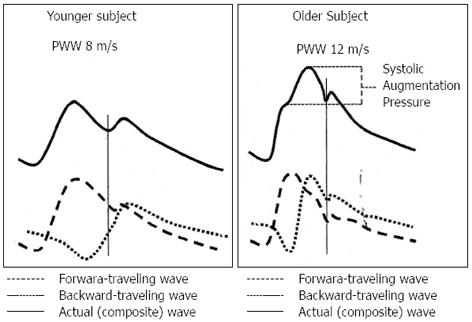Copyright
©2013 Baishideng Publishing Group Co.
Figure 2 This figure depicts the configuration of the arterial waveforms in the younger person (left) and the older person (right).
The arterial waveforms are composite waves (top heavy line), composed of a forward traveling wave (dashed line) and a backward traveling reflective wave (dotted line). The vertical line represents the closure of the aortic valve. The top solid line indicates the peak systolic blood pressure (SBP) in the younger person (left) and the older person (right) together with the augmentation pressure. The reflected wave in the younger person (left), returns to the aortic root early in diastole augmenting the diastolic blood pressure and improving the coronary circulation. In the older person (right), the reflected wave returns to the aortic root late in systole, thus augmenting the SBP and increasing the left ventricular outflow pressure leading to left ventricular hypertrophy. Due to the arterial stiffness in the older person, the pulse wave velocity is increased (12 m/s) compared to the younger person (8 m/s). Adapted with permission from Franklin et al[12].
- Citation: Chrysant SG. Treating blood pressure to prevent strokes: The age factor. World J Cardiol 2013; 5(3): 22-27
- URL: https://www.wjgnet.com/1949-8462/full/v5/i3/22.htm
- DOI: https://dx.doi.org/10.4330/wjc.v5.i3.22









